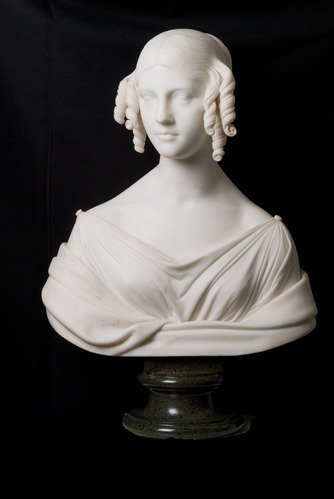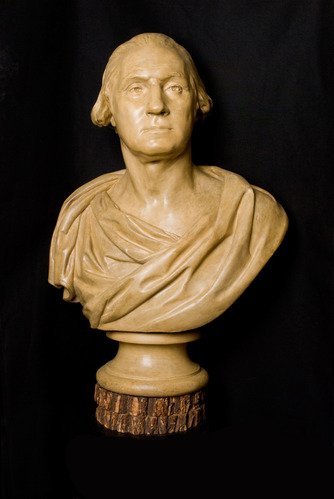6. Parlor/ Reception Room
Though the house has gone through several alterations over the centuries, some things remain little touched since the house was originally built in the 1750s. An example is the parlor also called the reception room. The white painted wood, though in the same design it was in the 18th century, we highly suspect, was originally left natural, with perhaps a aesthetic stain. But as time progressed and styles changed the wood was painted white and that is how it has remained.
Also here in the parlor, is a bust of Henry’s wife, Fanny. Born in 1817, Frances Elizabeth Appleton, who was lovingly referred to as Fanny, was the daughter of Nathan and Maria Appleton. The Appleton’s were part of the influential upper class of New England known as Brahmins. Fanny was a bright child whose love for knowledge was fueled by an education that was quite impressive for a young lady of the 19th century. Fanny studied a variety of subjects that included French, Latin, history, and geography, and was under the tutelage of some of Boston’s finest instructors like Elizabeth Palmer Peabody and George Barrell Emerson.

Shortly after the death of her brother Charles in 1835, Fanny’s father, Nathan, took the family on a “Grand Tour”. The Grand Tour was an extended vacation and learning experience typical of the wealthy class in the 19th century. While in Florence in the spring of 1836, Fanny posed for a marble bust by Italian artist Lorenzo Bartolini, which is the one currently in the parlor. While the Appletons were on the Grand Tour in Europe, they met a young Henry Wadsworth Longfellow in Switzerland who quickly fell smitten with Fanny. After several years of failed courtship, Fanny and Henry eventually married in 1843 and came to live on Brattle Street in Cambridge.
Fanny was much more than a loving wife and mother to their children she was a partner; a practical helper and a large source of inspiration. In the latter half of the 1840s when Henry had a difficult time seeing, she would act as a scribe writing his prose, he recited to her. Fanny would also edit some of his works when needed. As an educated woman, she played an active role in their children’s education. Though she believed that women should not be able to vote, which was contrary to the beliefs of many 19th century women, her political ideas and thoughts were held in high regard by her husband and their social circle. Often, she entertained friends of that circle like U.S. statesman Charles Sumner, here in the parlor.

On the parlor wall is a picture of Henry and Fanny’s two sons, Charley and Erny. Charley was the wild child of the family, he ran away at age eighteen to fight for the Union Army in the American Civil War. Charley received a near-fatal wound that forced him to return to Cambridge, where he did not stay for long. Charley traveled the world, filling the house with items from his trips to Asia, the Middle East, and Europe. Erny on the other hand was introspective, and a quiet child who grew up to be an artist.
Like the parlor, the staircases in the house also have their original 18th-century paneling that was painted white to reflect changing styles and tastes. Again in “The Children’s Hour” Longfellow mentions his children but also included the staircase.
“A sudden rush from the stairway,
A sudden raid from the hall!
By three doors left unguarded
They enter my castle wall!”
The stairs the Longfellow children played on are the same stairs General George Washington used when retiring to his bedroom after a long day's work or coming downstairs to greet his staff and visitors to the house. In honor of Washington, the Longfellows acquired a copy of the Houdon bust of the General in 1844 and placed him next to the staircase.
HOW HAVE YOUR TASTES CHANGED OVER TIME?
